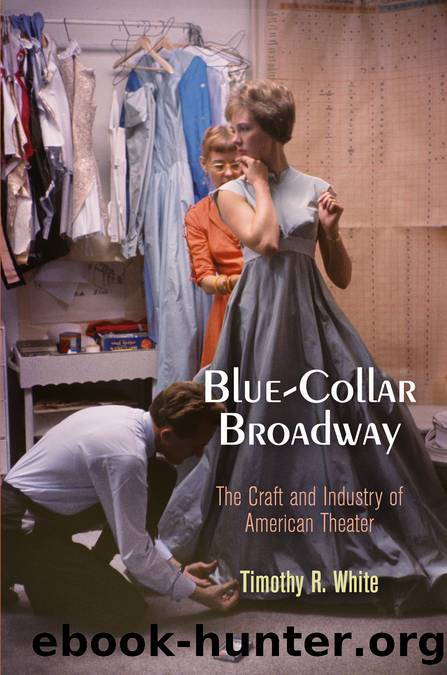Blue-Collar Broadway by White Timothy R.;

Author:White, Timothy R.;
Language: eng
Format: epub
Publisher: University of Pennsylvania Press
Published: 2015-08-15T00:00:00+00:00
Transfers and Tours
Back in the honeymoon phase of the regional movement, before most of these performing arts centers had broken ground, artistic directors spoke of liberating actors, designers, and audiences from the crass, commercial clutches of Broadway. In an interview for âBackstage in the Beer City,â Milwaukeeâs artistic director celebrated his troupeâs raison dâêtre in 1968: âAudiences must have at least one theatre in which they can go to see the great works of the past . . . unless cities like Milwaukee do this, the only other alternative is the jungle of Broadwayâthe âshow bizââwhich has nothing to do with the art of the theatre, but is a way of making money.â36 This artistic director along with Zelda Fichandler, Stuart Vaughan, and many others aspired to more than just an alternative theater; they sought a superior theater.
This is why so many of them began cut off from Broadway, building shows without so much as a stitch or swatch imported from New Yorkâs historic craft businesses. The fledgling experiments of Margo Jones in Dallas, the hardscrabble plays performed under a sycamore in Houston, and even the fully fledged, celebrated Hamlet in Minneapolisâall were built locally. If a New York scenic carpenter or costume cutter was lucky enough to score a salaried job at a regional facility, he or she could certainly relocate. Most of the time, however, regional jobs had almost nothing to do with those who stayed put in New York.
When hit shows began to be transferred from regional theaters to Broadway, this dynamic quickly changed. The Great White Hope, a hit play of the Arena Stageâs 1967 season, was the first notable piece to turn Broadwayâs show-originating hegemony on its head. In this particular case the creativity of the hinterlands circled back to employ New Yorkers. The leading player James Earl Jones so electrified audiences at the Arena Stage that New York producer Herman Levin optioned the property for a Broadway run in 1968. When the transfer production arrived for an October opening at the Alvin Theater, New Yorkâs unionized scenic carpenters, costume craftspeople, and lighting riggers secured two months of work, crafting new components to appear onstage within their jurisdiction. Even the drapery firm Dazianâs got work from the gig, hanging drops and curtains behind the Alvinâs proscenium in ways not needed for the Arenaâs original theater-in-the-round staging.
When The Great White Hope proved to be as much of a knockout on Broadway as it had been inside the beltway, other producers followed Levinâs lead. A different but equally enthusiastic group of New York producers pounced on the Arena Stageâs next hit in 1973, quickly transferring the musical Raisin to the 46th Street Theatre on Broadway. In doing so they put several local craft firms to work, just as Levin had. Other producers transferred plays from Houston and New Havenâs resident theaters within the same decade. The dynamic between Broadway and the regionals was transformed as âa long line of plays and musicalsâ flowed into rather than out of New York.
Download
This site does not store any files on its server. We only index and link to content provided by other sites. Please contact the content providers to delete copyright contents if any and email us, we'll remove relevant links or contents immediately.
| Acting & Auditioning | Broadway & Musicals |
| Circus | Direction & Production |
| History & Criticism | Miming |
| Playwriting | Puppets & Puppetry |
| Stage Lighting | Stagecraft |
Call Me by Your Name by André Aciman(18988)
Ready Player One by Cline Ernest(12863)
How to Be a Bawse: A Guide to Conquering Life by Lilly Singh(6701)
Wiseguy by Nicholas Pileggi(4600)
The Kite Runner by Khaled Hosseini(4471)
On Writing A Memoir of the Craft by Stephen King(4221)
The Crown by Robert Lacey(4114)
Audition by Ryu Murakami(4106)
Call me by your name by Andre Aciman(4079)
Harry Potter and the Cursed Child: The Journey by Harry Potter Theatrical Productions(3983)
Gerald's Game by Stephen King(3927)
The Perils of Being Moderately Famous by Soha Ali Khan(3789)
Dialogue by Robert McKee(3592)
Dynamic Alignment Through Imagery by Eric Franklin(3498)
Apollo 8 by Jeffrey Kluger(3205)
How to be Champion: My Autobiography by Sarah Millican(3193)
Seriously... I'm Kidding by Ellen DeGeneres(3106)
Darker by E L James(3093)
History of Dance, 2E by Gayle Kassing(3001)
